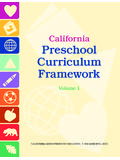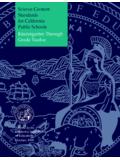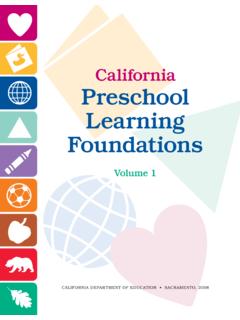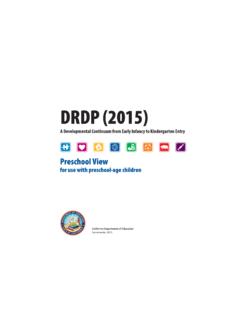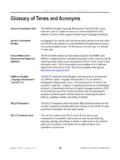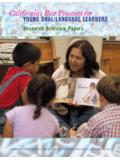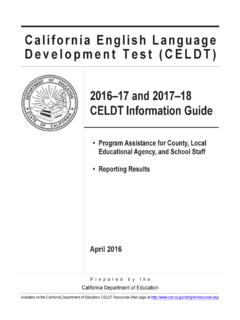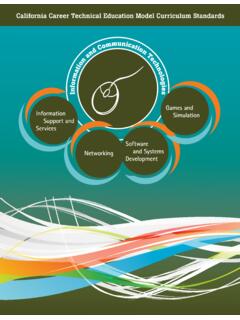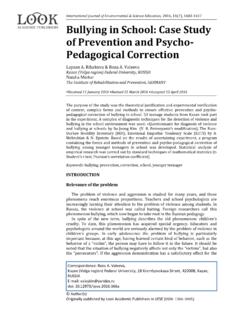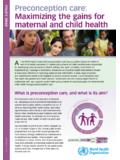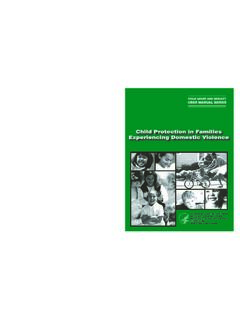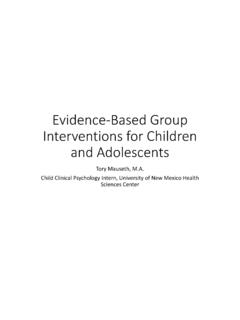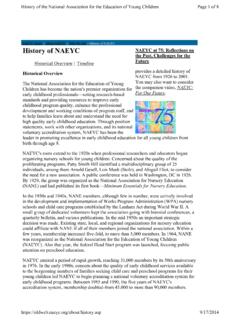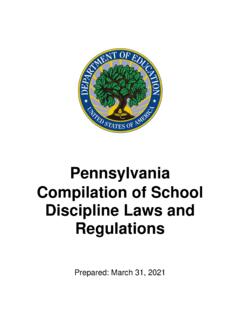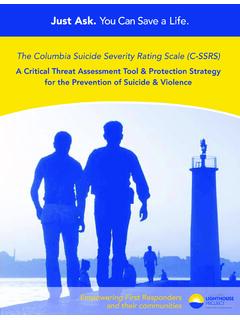Transcription of Health Education Content Standards for California Public ...
1 Health Education Content Standards for California Public SchoolsKindergarten Through Grade TwelveWhen the Health Education Content Standards for California Public Schools, Kindergarten Through Grade Twelve was adopted by the California State Board of Education on March 12, 2008, the members of the State Board were the following: Theodore Mitchell, President; Ruth Bloom, Vice President; James Aschwanden; Alan Bersin; Yvonne Chan; Gregory Jones; David Lopez; Kenneth Noonan; Johnathan Williams; and Monica publication was edited by John McLean, working in cooperation with Mary Marks, Consultant, Learning Support and Partnerships Division. It was prepared for printing by the staff of CDE Press: Cheryl McDonald created and prepared the cover and interior design; Jeannette Reyes typeset the document. It was published by the Department of Education , 1430 N Street, Sacramento, CA 95814-5901. It was distributed under the provi-sions of the Library Distribution Act and Government Code Section 11096.
2 2009 by the California Department of Education All rights reservedISBN 978-0-8011-1695-7 Publishing InformationAcknowledgmentsThe State Board of Education extends its appreciation to the members and staff of the California Health Education Standards Advisory Panel for their outstanding work in developing and recommending the Health Education Content Standards to the State Board of Education under the provisions of Education Code Section State Superintendent of Public Instruction Jack O Connell appointed the following educators to the California Health Education Standards Advisory Panel: Martha Adriasola-Martinez, San Francisco Unified school DistrictBeverly Bradley, school Health Consultant, San DiegoMarilyn Briggs, University of California , DavisLaurie Brown, Los Angeles Unified school DistrictSally Champlin, California State University, Long BeachKim Clark, California State University, San BernardinoSheri Coburn, San Joaquin County Office of EducationCornelia Finkbeiner, Menlo Park City Elementary school DistrictLaura Griffith, Los Angeles Unified school DistrictSloan Holmes, Kern Union High school DistrictTad Kitada, Placer County Office of EducationRic Loya, Los Angeles Unified school DistrictSarah Miller, Hayward Unified school DistrictKristine Pasquini, Clovis Unified school DistrictMiguel Perez, California State University, FresnoAnn Rector, Pasadena Unified school DistrictChristopher Saldivar, Belmont-Redwood Shores Elementary school DistrictCarol Shaw, Sweetwater Union High school DistrictRobin Sinks.
3 Long Beach Unified school DistrictSpecial commendation is extended to Gordon Jackson, Director, Learning Support and Partnerships Division; Phyllis Bramson-Paul, Director, Nutrition Services Division; Caroline Roberts, former school Health Connections/Healthy Start Administrator; Jennifer Rousseve, school Health Connections/Healthy Start Administrator; Mary Marks, school Health Education Consultant; Sharla Smith, HIV/STD Prevention Education Consultant; Donna Bezdecheck, school Health Education Consultant; Margaret Aumann, Nutrition Education Consultant; and Deborah Wood, Executive Director, California Healthy Kids Resource Center. Their significant contributions to this document deserve special InformationCopies of this publication are available for sale from the California Department of Education . For prices and ordering information, please visit the Department Web site at or call the CDE Press Sales Office at 1-800-995-4099. An illustrated Educational Resources Catalog describing publications, videos, and other instructional media available from the Department can be obtained without charge by writing to the CDE Press Sales Office, California Department of Education , 1430 N Street, Suite 3207, Sacramento, CA 95814- 5901; faxing to 916-323-0823; or calling the CDE Press Sales Office at the telephone number listed guidance in Health Education Content Standards for California Public Schools, Kindergarten Through Grade Twelve is not binding on local educational agencies or other entities.
4 Except for the statutes, regulations, and court decisions that are referenced herein, the document is exemplary, and compliance with it is not mandatory. (See Education Code Section )iiiA Message from the State Board of Education and the State Superintendent of Public Instruction ..vIntroduction ..viKindergarten ..1 Grade One ..6 Grade Two ..10 Grade Three ..14 Grade Four ..18 Grade Five ..23 Grade Six ..28 Grades Seven and Eight ..33 High school (Grades Nine Through Twelve) ..45 Appendix: The Overarching Health Education Content Standards ..57 Glossary ..58 ContentsvGood Health and academic success go hand in hand. Healthy children make better students, and better students become healthy, successful adults who are productive members of their communities. Comprehensive Health Education that addresses the physical, mental, emotional, and social aspects of Health teaches students how to maintain and improve their Health ; prevent disease; reduce Health -related risk behaviors; and develop Health knowledge, attitudes, and skills that foster academic achievement, increase attendance rates, and improve behavior at with students throughout the United States, California s students are facing increasingly serious challenges to good Health : obesity and diabetes are rising at alarming rates; asthma continues to be a leading cause of student absences; and too many adolescents continue to make choices that negatively impact their lives.
5 It is essential that students learn how to manage Health problems they already face and to avoid additional Health problems in the future. Students need Health Health Education programs help students achieve their highest academic potential. The Health Education Content Standards for California Public Schools, Kindergarten Through Grade Twelve provides guidance on the essential skills and knowl-edge that students should have at each grade level. Local educators are encouraged to apply these Standards when developing curricular and instructional strategies for Health Education and other interdisciplinary the significant impact of Health on academic achievement, we must do everything possible to improve the quality of Health Education in California schools. The Health Education Content Standards represent our commitment to promoting excellence in Health Education for all R. Mitchell President, State Board of EducationJack O Connell State Superintendent of Public InstructionA Message from the State Board of Education and the State Superintendent of Public InstructionviHealth Education is a continuum of learn-ing experiences that enables students, as individuals and as members of society, to make informed decisions, modify behaviors, and change social conditions in ways that are Health enhancing and increase Health lit-eracy.
6 The Health Education Standards define the essential skills and knowledge that all students need in order to become Health literate ; they represent a strong consensus of the essential knowledge and skills that students should have at specific grade levels, from kindergarten through grade twelve, in California s Public schools. The Health educa-tion Standards also reflect California s commit-ment to Health Education and serve as a basis for learning assessments, the Health Framework for California Public Schools, and instructional resources and materials. Standards do not prescribe methods of instruction. A primary goal of the Health Education Standards is to improve academic achieve-ment and Health literacy for all students in California . Four characteristics are identified as essential to Health literacy. Health -literate individuals are: Critical thinkers and problem solverswhen confronting Health problems andissues Self-directed learners who have the com-petence to use basic Health informationand services in Health -enhancing ways Effective communicators who organizeand convey beliefs, ideas, and informa-tion about Health issues Responsible and productive citizenswho help ensure that their communityis kept healthy, safe, and secureThese four essential characteristics of Health -literate individuals are woven throughout the Health Education of the StandardsIn October 2005, Assembly Bill (AB) 689, cosponsored by State Superintendent of Public Instruction (SSPI) Jack O Connell, was signed into law by Governor Arnold Schwarzenegger, adding Section to the California Education Code (EC).
7 That section required the State Board of Education (SBE), based on recommendations from the SSPI, to adopt Content Standards for Health Education . The Health Education Standards shape the direction of Health Education instruction for children and youths in California s Public schools: they provide school districts with fundamental tools for developing Health Education curricula and improving student achievement in this area; and they help ensure that all students in kindergarten through high school receive high-quality Health Education instruction, providing students with the knowledge, skills, and confidence to lead healthy lives. Health Education has undergone a paradigm shift over the last 15 years. It has evolved from a primarily knowledge-based subject to a focused, skills-based subject. This shift came about as data from national and state surveys including the California IntroductionviiIntroductionHealthy Kids Survey indicated that although youths had knowledge of what was harmful to their Health , they did not have the skills to avoid risky behaviors.
8 The students under-stood why certain behaviors could and would cause harm, but they still engaged in risky focus in the Health Education Standards is on teaching the skills that enable students to make healthy choices and avoid high-risk behaviors. Eight overarching Standards describe essential concepts and skills; they are taught within the context of six Health Content areas. Each skill is learned and practiced specific to the Content area and Essential DisciplineHealth Education is an integral part of the Education program for all students. Grounded in the body of sound Education research, the Health Education curricula in local school dis-tricts should be organized into a scope and sequence that support the development and demonstration of increasingly sophisticated essential knowledge, attitudes, and skills. A comprehensive Health Education program is designed to promote healthy living and discourage Health -risk behaviors among all Health Education programs include structured learning opportunities that engage students as active learners.
9 Through quality instructional approaches, learners increase essential knowledge and are encouraged to compare and contrast their beliefs and perceptions about Health issues. Schools are in a unique and powerful position to improve Health outcomes for youths. Today s young people are confronted with Health , educa-tional, and social challenges not experienced to the same degree by previous generations; violence, alcohol and other drug use, obesity, unintended pregnancy, sexually transmitted diseases (STDs), and disrupted family environments can compromise academic success and Health . Students should have an opportunity to practice essential skills to maintain healthy lifestyles. Such a foundation is reflected in the Health Education Content Standards . Teachers and school districts are encour-aged to enrich their students instructional environments and learning opportunities by: Using Standards -based, theory-driven,and research-based approaches to healthinstruction Identifying and collaborating withappropriate community and healthagencies Cultivating meaningful parentinvolvement in Health Education Focusing instruction on essentialknowledge and skills that will fosterhealth-risk reduction among studentsOverarching Content Standards and RationalesThe eight overarching Health Content Standards for kindergarten through grade twelve are presented below, along with the rationale for each 1: Essential Health ConceptsAll students will comprehend essential concepts related to enhancing.
10 Understanding essential concepts about the relationships between behavior and Health provides the foundation for making informed decisions about Health -related behaviors and for selecting appropriate Health products and 2: Analyzing Health InfluencesAll students will demonstrate the ability to analyze internal and external influences that affect : Health choices are affected by a variety of influences. The ability to recognize, viiiIntroductionanalyze, and evaluate internal and external influences is essential to protecting and enhancing Health . Standard 3: Accessing Valid Health InformationAll students will demonstrate the ability to access and analyze Health information, products, and : Students are exposed to numerous sources of information, products, and services. The ability to access and analyze Health information, products, and services provides a foundation for practicing Health -enhancing behaviors. Standard 4: Interpersonal CommunicationAll students will demonstrate the ability to use interpersonal communication skills to enhance : Positive relationships support the development of healthy attitudes and behaviors.
